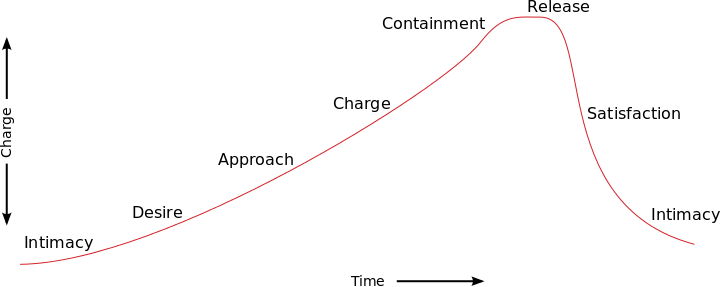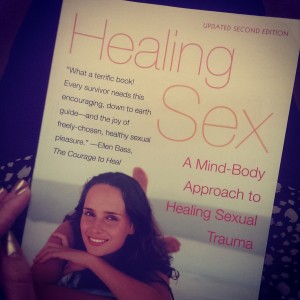You will often hear me say that sexuality is a deep and complex landscape. That is largely why it’s wonderful- it’s rich and expansive and can bear our multitudes, if we tend to it successfully. There is one aspect, however, that isn’t so complex, and that is the orgastic cycle.
Some of you may be familiar with the work of Virginia Johnson and William Masters in Human Sexual Response from 1966 (a great year for cars), because it’s what most of us who were lucky enough to have sex ed learned in school. It’s good and valuable work focusing on the physiology of the sexual response. I highly recommend reading it. It’s your body after all. Why not understand it?
Here, I will give an overview of the orgastic release cycle as defined by the Integrative Body Psychotherapy (IBP) Model. This model allows us to understand the emotional landscape involved with each physical response. Here’s the TLDR version, but good luck stopping there!:
 Without further reading, you probably have a sense of what each of these stages means. Each of us has a particular relationship to this cycle and therein lies the material point. As Rosenberg puts it, “The way you do your orgasm is the way you do your life.”
Without further reading, you probably have a sense of what each of these stages means. Each of us has a particular relationship to this cycle and therein lies the material point. As Rosenberg puts it, “The way you do your orgasm is the way you do your life.”
For a happy, healthy, and fun sex life, it’s important to have a sense of which phase(s) you’re adept at managing and which ones are more difficult. These phases show up in nearly every aspect of our lives. So let’s look at each a little more in depth.
Intimacy
Intimacy is absolutely essential to this process. It’s necessary that you feel comfortable and safe, that you genuinely like your partner, and that you open up to them. Only with intimate familiarity can you have flow into desire.
Desire
To understand what’s happening in this stage, I like to think of it as an analysis of your raw materials: are you working with a healthy body, and do you let it do its thing? Your body must have the ability to be aroused, and you have to be willing to let it. Factors like clinical depression and “hangups” (a word I don’t love, but it makes its point) greatly affect our ability to become aroused. When I have a client who is struggling with this stage, we begin by ruling out physiological factors via a visit to the doc, endocrinologist, or psychiatrist. While physical symptoms are not at all separate from our psychology, we must know what we’re working with and what resources will aid our journey. After all, if we can’t get the engine started, we aren’t going to get anywhere.
Approach
Approach is about your ability to ask for what you want. Successful approach entails being willing to ask, having different ways of asking (plenty of verbal and nonverbal), and being approachable yourself. If you’re struggling here, you might never be the one asks (or you always are), you feel rejected easily, you let yourself get overtired at night, etc.
Charge
Where desire is the ability to feel drawn to aliveness, charge is the ability to experience it directly. Sexual charge is created by all the lovely touching, kissing, smelling, tasting, thinking, seeing, talking, dancing, holding, hugging, etc. Struggling with this stage can manifest as a need for conflict to be aroused, a feeling of overwhelm, checking out/dissociating, etc.
Containment
Containment is your ability to tolerate the charge that’s been built. Successful containment means savoring the charge for a while. The term “plateau” from Johnson and Master’s work is fitting here. Can you hang out in the nice feelings for a while, allowing for a plateauing effect on your arousal level? One obvious example of containment difficulty is premature ejaculation, but struggling here can also mean making attempts to lower your charge by talking, wiggling, holding your breath, etc.
Release
Now that all that lovely charge has been built up, it needs to go somewhere. Releasing means allowing the charge to flow out of you. I don’t mean just ejaculate, either! The release stage is where the heart opens its gates without knowing just when they’ll be shut again. Holy vulnerability, Batman! Because of how vulnerable you must be, two main problems often arise here: refusal to let go, and the need for super duper specific conditions for orgasm. Releasing successfully means letting go, and staying present while doing so. This is where all that hard work pays off. It’s no wonder we can be “orgasm-focused,” is it? What a beautiful experience this can be when we execute it well.
Satisfaction
I like to think of this stage as your ability to take a snapshot of your sexual experience and carry it with you. After orgasm, your body is being flooded with oxytocin. Will you allow it to wash over you or will you try to run away from it? Achieving satisfaction means staying present a while longer to take in this wonderful experience. Appreciate it. Let it brighten you up. Look your partner in the eyes and store this memory. Sometimes we block our ability to feel satisfied by immediately distracting ourselves, picking a fight, feeling abandoned or guilty, etc.
Intimacy
Completion of the orgastic cycle should bring feelings of increased love, closeness, and relaxation, which fuel us in moving forward. We carry these things with us until the next stage begins again.
Earlier, I said that this cycle applies to just about everything. And I meant it! That’s part of what makes it less complex than all the rest of what might be included on the topic of sexuality. The cycle always has these stages and the same stages show up in different contexts, including nonsexual ones. The experiences that we have, both good and bad, strengthen and weaken our ability to execute different stages. That’s why it shows up all over the place! I’ll leave you with some considerations.
Think about how you typically decide what to eat and what factors affect your process. How exact does a dish need to be for it to be appetizing to you? Think about how you actually consume the food (how quickly, how neatly or messily, how much). And consider how you feel afterwards.
To understand our sexuality is to understand ourselves. Individual and couples therapy is a gift that you give yourself in order to live your life as you should for you. Call or email to schedule an introductory session.
For further reading on this and other IBP models, check out their website and books. I particularly recommend The Intimate Couple.



